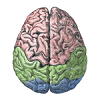9.2: Biology of Language
- Page ID
- 12616


The classic "textbook" brain areas for language are Broca's and Wernicke's areas (Figure 9.1), which have been associated with syntax and semantics, respectively. For example, a person who suffers a stroke or other form of damage to Wernicke's area can produce fluent, syntactically-correct speech, which is essentially devoid of meaning. Here is one example:
- "You know that smoodle pinkered and that I want to get him round and take care of him like you want before", which apparently was intended to mean: "The dog needs to go out so I will take him for a walk".
In contrast, a person with damage to Broca's area has difficulty producing syntactically correct speech output, typically producing single content words with some effort, e.g., "dog....walk".
The more modern term for Broca's aphasia is expressive aphasia, indicating a primary deficit in expressing speech. Comprehension is typically intact, although interestingly there can be deficits in understanding more syntactically complex sentences. Wernicke's aphasia is known as receptive aphasia, indicating a deficit in comprehension, but also expression of meaning.
Biologically, the locations of the damage associated with these aphasias are consistent with what we know about these areas more generally. The ventral posterior area of frontal cortex known as Broca's area (corresponding to Brodmann's areas 44 and 45) is adjacent to the primary motor area associated with control over the mouth, and thus it represents supplementary motor cortex for vocal output. Even though Broca's patient's can physically move their mouths and other articulatory systems, they cannot perform the complex sequencing of these motor commands that is necessary to produce fluid speech. Interestingly, these higher-order motor control areas also seem to be important for syntactic processing, even for comprehension. This is consistent with the idea that frontal cortex is important for temporally-extended patterning of behavior according to increasingly complex plans as one moves more anterior in frontal cortex.
The location of Wernicke's area in temporal cortex is sensible, given that we know that the temporal lobe represents the semantic meanings of objects and other things.
There are still some controversies about the exact nature of damage required to produce each of these aphasias (and likely a large amount of individual variability across people as well), but the basic distinction between these broad areas remains quite valid.
The Articulatory Apparatus and Phonology



The vocal tract in people (Figure 9.2) is capable of producing a wide range of different speech sounds, by controlling the location and manner in which sound waves are blocked or allowed to pass. There are two basic categories of speech sounds: vowels and consonants. Vowels occur with unobstructed airflow (you can sing a vowel sound over an extended period), and differ in the location of the tongue and lips (Figure 9.3 and Figure 9.4). For example, the long "E" vowel sound as in "seen" is produced with the tongue forward and the lips relatively closed. Consonants involve the blockage of airflow, in a variety of locations, and with a variety of different manners (Figure 9.5). The "s" consonant is a "fricative" (friction-like obstruction of the sound) with the tongue placed at the aveloar ridge. It is also unvoiced, which means that the vocal chords are not vibrating for it -- the "z" sound is just like an "s" except it is voiced.
To see a video of the movements of the tongue in vocal output, see this YouTube link: http://www.youtube.com/watch?v=M2OdAp7MJAI
We'll take advantage of these phonological features in the output of our detailed reading model -- using these features ensures that the spelling-to-sound correspondences actually capture the real phonological structure of the English language (at least at a fairly abstract level). A more detailed motor model of speech output developed by Frank Guenther, which we hope to include in our models at some point, can be found here: speechlab.bu.edu/diva.php


